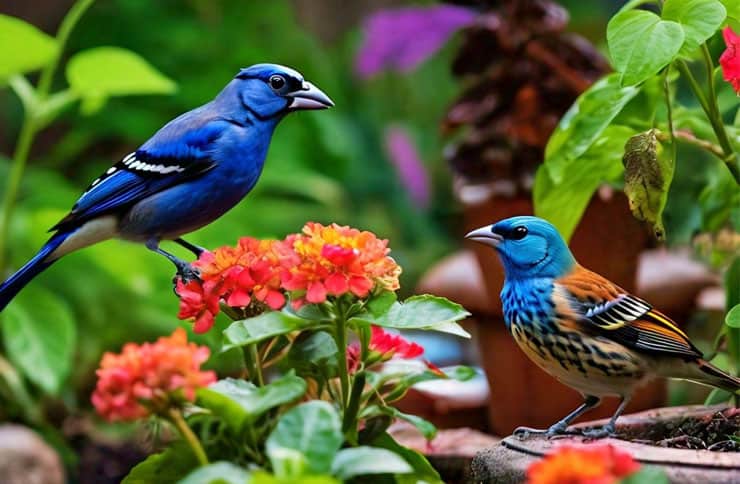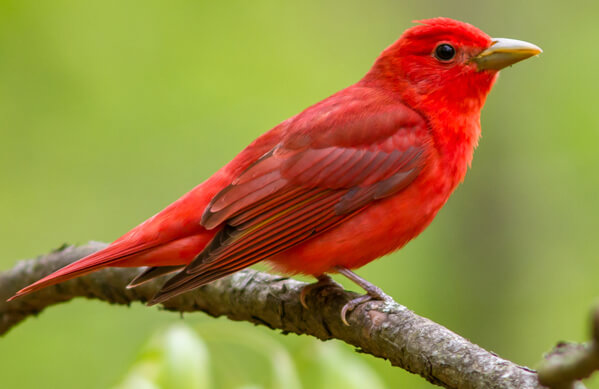House Finch vs Purple Finch: Spot the Difference
Today we’ll guide you on how to identify House Finch vs a Purple Finch? Purple Finches aren’t purple, and House Finches don’t live on houses. This makes it tricky to tell them apart. You might see a bird with red and brown feathers, wondering which kind it is. This guide will help you figure out the differences. We’ll look at where they live, what they look like, how they nest, and what they eat. This will make it easier to spot the right bird in your backyard.
Introduction to House Finch and Purple Finch
The House Finch and Purple Finch both love seeds and are easy to mix up. This is especially true for the females and young birds. Yet, telling them apart is key. They have different homes, ways of living, and behaviors. Knowing how to spot the difference helps us learn about the birds around us. It also supports caring for their habitats better.
Similarities and Differences at a Glance
House finches and purple finches look alike at first glance. They’re both on the small side, with short beaks and notched tails. But, their colors, shapes, and even how they act are different. These small details are crucial for knowing which finch is which. It’s important for bird fans who want to get to know their local feathered friends.

Importance of Proper Identification
Getting house finches and purple finches right is very important. It helps you see how many different birds are in your area. And, it lets you help with saving these birds. Knowing which is which also means you can make your yard a great place for them. By learning to tell them apart, you become a better bird watcher. You’ll enjoy watching them even more.
Range and Distribution
House Finches are found almost everywhere in North America, including Hawaii. Originally native to the southwest, they have spread east since the 1940s. On the other hand, Purple Finches live in Canada, the Pacific coast, and the Northeast. They travel to the South in winter, but mainly avoid the Interior West. There are places where house finches and purple finches share ranges. This leads to difficulties in telling them apart, especially in the Northeast and some parts of the West.
Native Habitats of House Finches
House Finches are very adaptable. They live in all kinds of places, from cities to deserts. This adaptability helps them live all across North America.
Breeding and Wintering Grounds of Purple Finches
Purple Finches like coniferous and mixed forests. They look for dense cover and big trees to mate and raise their young. Come winter, they fly to the South, with a few going as far as Florida. But they usually don’t go to the Interior West.
Overlapping Regions and Migration Patterns
In some parts of North America, the ranges of house and purple finches meet. This happens in the Northeast and parts of the West. This overlap makes it hard to tell them apart, especially in winter when purple finches leave their nests.
Coloration and Markings
House finches and purple finches have unique colors and marks. These features help us know which is which. We’ll learn how to spot the males and females of both kinds.
Identifying Male House Finches
Male House Finches can have various shades of red. They may have orange accents or be fully red. The bright red comes from their food, which is rich in carotenoids.
Distinguishing Male Purple Finches
Male Purple Finches always show striking pinkish red hues. Unlike House Finches, their colors are deeper and more vivid. This makes them stand out.
Females and Immature Birds
Females and young House and Purple Finches can be hard to distinguish. They all look brown and streaked. But, female Purple Finches have a clear white eyebrow and dark, bold patterns. This makes them different from the simpler female House Finches.
house finch vs purple finch
Overall Body Shape and Structure
The house finch and the purple finch look different beyond their colors. House Finches have a rounder look up front. In comparison, Purple Finches appear more straight with a seamless back-to-head line.
Beak and Tail Characteristics
The House Finch boasts a bulky, round beak. On the other hand, the Purple Finch’s bill is pointed and conical. House Finches also sport longer tails, extending past their wingtips. In contrast, Purple Finches have shorter, notched tails.
House Finch vs Purple Finch: Nesting and Breeding Behavior
House Finches and Purple Finches have different ways of nesting and breeding. House Finches are good at changing and build nests in various places. They use man-made spots like ledges and gutters and also trees and shrubs. Because of this, they can live in cities and the countryside.
Nest Construction and Site Selection
Purple Finches, on the other hand, like a very specific kind of place for their nests. They choose to nest in cup-shaped nests in the branches of coniferous or mixed forests. So, you can find them in dense, mature woods more often.
Courtship and Mating Rituals
Both finch types go all out to find a partner. Male House Finches sing and fly in special patterns. For Purple Finches, the males team up with other birds in the winter. Here, they show off their bright colors and songs to female Purple Finches.
Feeding Habits and Preferences
House Finches and Purple Finches both love seeds, especially sunflower seeds. They use their strong beaks to crack seeds at bird feeders. House Finches prefer to stay and feed at the feeder. In contrast, Purple Finches grab a seed and quickly fly off.
Preferred Food Sources
In the winter, both types of finches like sunflower seeds. In summer, they eat fruits, seeds, and bugs from native plants. They prefer feeders with unhulled black oil sunflower seeds because they are high in energy.
Foraging Techniques
House Finches usually perch at the feeder to eat. On the other hand, Purple Finches’ foraging is more active. They quickly grab a seed and fly away to eat it in a tree or shrub. This makes them harder to spot at feeders.
Attracting Finches to Backyard Feeders
To bring House Finches and Purple Finches to your yard, offer different seeds. Use black oil sunflower, nyjer, and millet seeds. Place feeders in various spots to match their feeding behaviors. This way, you can watch these bright birds all year.
Vocalizations and Calls
House Finches and Purple Finches have different sounds. This helps us tell them apart. House Finches sing cheerfully with lots of chirps and trills. They also have a sharp “chip” call.
House Finch Songs and Calls
The males of House Finches sing in three main ways. These include a “warbling song” and a song to mark their territory. They also use an up-and-down cadence. Female House Finches sing a long, warbling song from their nest. This song can last 1-2 minutes. They use a short “tek” sound as their usual call note, showing how they communicate vocally.
Purple Finch Vocalizations
Purple Finches have a rich and melodious song. It includes clear, whistled phrases. Their calls are a dry, harsh “che-up” or a softer “chup” sound. In the West, in places like Oregon and California, their songs and calls can be heard.

Habitat and Environmental Factors
House finches and purple finches like different places to live. House finches are very adaptable. They can live in many places, from cities to the wilds, including deserts and woods. They have spread across the U.S., parts of Canada, and Mexico because they can live near people.
Preferred Habitats
Purple finches, however, prefer certain types of forests. They like coniferous and mixed forests with lots of plants and big trees. These places have the food and safe spots they need for their families.
Impact of Human Development
Urban and suburban growth can harm both finch species. Growing cities and towns take away their homes. This loss makes it hard for the birds to find food and places to raise young.
Conservation Efforts
Conservation works to help house finches and purple finches. We can keep natural areas wild and garden in ways that help birds. This includes planting the right plants and making safe places for them.
Identifying Challenges and Tips
Spotting house finches and purple finches can be hard. This is true, especially when they change their feathers. The color of a male house finch, for instance, can vary depending on what it eats and time of year. Telling the difference between female and young birds of these species adds to the challenge.
Seasonal Variations and Molting
House and purple finches look different throughout the year. Males show off their best colors during breeding time. But, their feathers become duller as they get ready for winter. Knowing these changes can make identifying the finches in your area easier.
Field Marks and Observation Techniques
Taking a good look at these finches can help. Notice the details in their shapes, beaks, tails, and feathers. Also, pay attention to how they act and the sounds they make. This can help you tell the two types of finches apart.
Using Birding Apps and Resources
Don’t forget, apps and guides can make this task easier. They offer descriptions, pictures, and comparison tools for correct identification. So, make the most of these resources. This way, you’ll get better at spotting house and purple finches in your area.
Read More Articles
| 5 Types of Grosbeak Birds You Should Know |
| Woodpecker Spiritual Meaning |
| Beautiful Birds in Minnesota |
| Top 10 Hawks in San Diego |
| Black Birds With White Wings |
Wrapping Up on House Finch vs Purple Finch
House finches and purple finches look alike on first sight. Yet, with a closer look, you can tell the difference between them. By noting their range, colors, nests, songs, and food, you can spot which is which. This helps you enjoy the many different birds in your area.
If you love watching birds, telling the house finch from the purple finch brings joy. Use guides, apps, and your own eyes to learn about these birds. This way, you’ll know more about the birds you see near your home.
Keep exploring these beautiful finches and see how varied our bird life is. Enjoy their unique traits and help protect them by learning more. This will make you better at spotting birds and help in their conservation.






